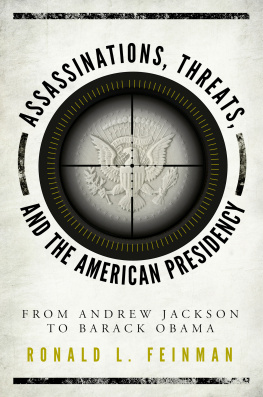Assassinations, Threats, and the
American Presidency
Assassinations, Threats, and the
American Presidency
From Andrew Jackson to
Barack Obama
Ronald L. Feinman
ROWMAN & LITTLEFIELD
Lanham Boulder New York London
Published by Rowman & Littlefield
A wholly owned subsidiary of The Rowman & Littlefield Publishing Group, Inc.
4501 Forbes Boulevard, Suite 200, Lanham, Maryland 20706
www.rowman.com
Unit A, Whitacre Mews, 26-34 Stannary Street, London SE11 4AB
Distributed by NATIONAL BOOK NETWORK
Copyright 2015 by Rowman & Littlefield
First paperback edition 2017
All rights reserved. No part of this book may be reproduced in any form or by any electronic or mechanical means, including information storage and retrieval systems, without written permission from the publisher, except by a reviewer who may quote passages in a review.
British Library Cataloguing in Publication Information Available
Library of Congress Cataloging-in-Publication Data
The hardback edition of this book was previously catalogued by the Library of Congress as follows:
Feinman, Ronald L.
Assassinations, threats, and the American presidency : From Andrew Jackson to Barack Obama / by Ronald L. Feinman.
p. cm.
Includes bibliographical references and index.
1. Presidents--Assassination--United States--History. 2. Presidents--Assassination attempts--United States--History. 3. Presidents--United States--Biography. I. Title.
E176.1.F39 2015
973.09'9--dc23
2014044057
ISBN 978-1-4422-3121-4 (cloth : alk. paper)
ISBN 978-1-4422-7951-3 (pbk. : alk. paper)
ISBN 978-1-4422-3122-1 (electronic)
 TM The paper used in this publication meets the minimum requirements of American National Standard for Information Sciences Permanence of Paper for Printed Library Materials, ANSI/NISO Z39.48-1992.
TM The paper used in this publication meets the minimum requirements of American National Standard for Information Sciences Permanence of Paper for Printed Library Materials, ANSI/NISO Z39.48-1992.
Printed in the United States of America
Dedicated to my brother, Morton Feinman, who was
always there for me throughout my life
Acknowledgments
No author can ever say that he has produced a work all on his own. Without the support and backing and cooperation of others, this work could not have been published.
I want to begin by thanking David Glauber, a former student of mine from Florida Atlantic University and professor at Broward College, who has always been one of my best friends and supporters in my long teaching career. David provided keen insights throughout the writing process and worked with me to produce the charts and the index, which add so much to this work. Without his critique of the first and second drafts of this book, it would not have been as good a book, and I cannot thank him enough for his commitment.
I also want to thank Peggy Mitchell, who has become a great friend of mine in the past few years, having first come to know each other through her reading of my political and historical blog, The Progressive Professor, since its inception in August 2008. As an experienced nurse and educator she is an expert on medicine, and her knowledge of gunshot wounds provided me with a greater understanding. She also offered a critique of the first and second drafts of this book.
I also wish to thank two colleagues, Dr. Stephen Engle of Florida Atlantic University and Professor Eleanor McCluskey of Broward College, for their expert reading of the third draft of the book, and their profound knowledge and wisdom. This book is better for their willingness to examine the manuscript.
Also, my best friend, Alan Borisman, gave me encouragement and support during the time of my writing and revising of this work. He has always been there for me in every way possible.
I also wish to thank Kathryn Knigge, my editor, who has been extremely cooperative and supportive of my efforts in producing this manuscript.
My son David Feinman, who amazes me every day with his intelligence, knowledge, and insights on so many topics, made a major difference with his reviewing and formatting of the second draft, and being so proud of his dad.
Also, my younger son, Paul Feinman, has been an inspiration and has provided great moral support in the creation of this work.
David and Paul know how much I love them, and how nothing matters more than family.
Introduction
Since the dawn of civilization, individuals and groups in every society have held grievances toward their nations leaders. Sometimes, they express themselves in terms of verbal protests, but other times their hostility turns violent. Assassination attempts against leaders have significantly shaped the course of world history and that of the United States.
One of the earliest assassinations from antiquity, Julius Caesar in 44 BCE, led to the fall of the Roman Republic and the rise of the Roman Empire.
The assassination of Archduke Franz Ferdinand, the heir to the throne of the Austro-Hungarian Empire, in 1914, set off the powder keg that became the disastrous World War I. This war transformed the world in many ways, including the rise of the Soviet Union, Fascist Italy, and Nazi Germany; long-term turmoil in the Middle East with the fall of the Ottoman Turkish Empire; the rise of nationalism in the British and French Empires in Africa and Asia, leading to massive changes; and the resentments built up by the war and the Great Depression, leading to World War II, and then the Cold War after that.
The assassination of Czar Alexander II of Russia in 1881 ended the quest for reform within the Russian government, led to further deterioration of the monarchy, and eventual overthrow of the Czarist government by Nikolai Lenin and the Bolshevik Revolution in 1917.
The assassination of Abraham Lincoln in the mid-nineteenth-century United States had a negative impact on the future of America over the next century, and the assassinations of John F. Kennedy and Robert F. Kennedy a century later transformed the second half of the twentieth century.
Political assassination has been one of the major themes of American history. Eleven presidents and three presidential hopefuls have been directly threatened by assassins. Mental illness or political and economic grievances have influenced these threats. A total of six of these fourteen incidents led to the death of the victim, with three others wounded, and five remaining unhurt, as a result of the assassination attempts.
Also, all five presidents still alive in 2015 have faced assassination threats both in and out of office. Finally, when one adds that Andrew Johnson was targeted to be killed when Abraham Lincoln was assassinated, but the potential assassin became intoxicated instead and Johnson remained unharmed, it means a total of seventeen presidents, and three presidential hopefuls, faced assassination threats or dangers. That means about 40 percent of our presidents can be documented as having been targeted by assassins.
The purpose of this book is to provide information and insight on all of the known facts of assassination threats and dangers for these seventeen presidents, plus the three candidates seeking the presidency who came under attack. One chapter will be devoted to each of the eleven presidents and three presidential aspirants who directly faced threats. Additionally, a careful study and analysis of the five living presidents and the threats they faced in the late twentieth and early twenty-first century will also be discussed.
Next page





![Blackstone Audio Inc. - The politically incorrect guide to the presidents: [from Wilson to Obama]](/uploads/posts/book/167736/thumbs/blackstone-audio-inc-the-politically-incorrect.jpg)

 TM The paper used in this publication meets the minimum requirements of American National Standard for Information Sciences Permanence of Paper for Printed Library Materials, ANSI/NISO Z39.48-1992.
TM The paper used in this publication meets the minimum requirements of American National Standard for Information Sciences Permanence of Paper for Printed Library Materials, ANSI/NISO Z39.48-1992.